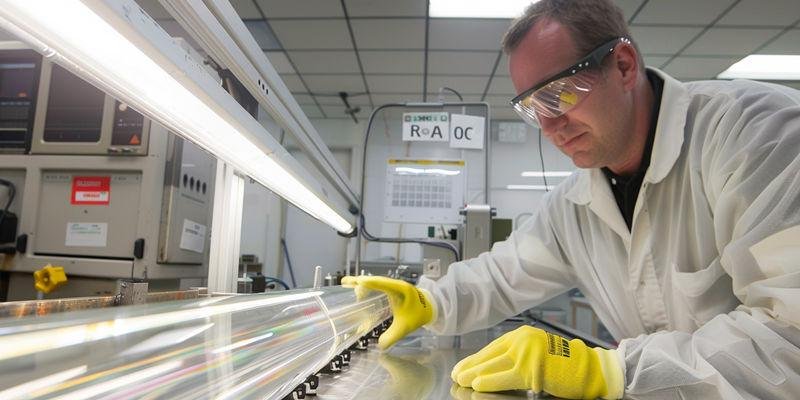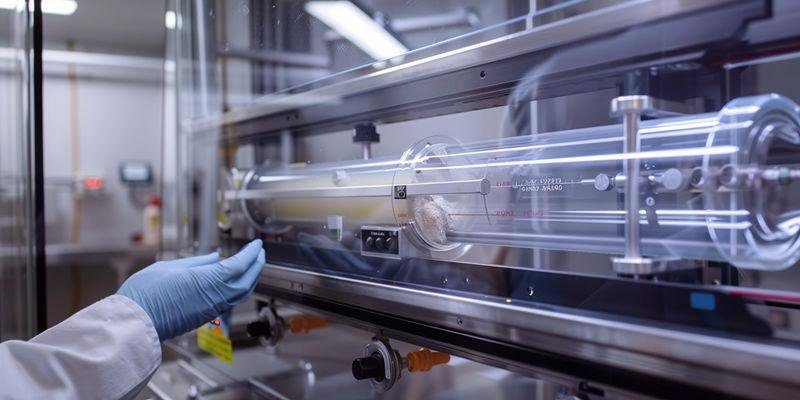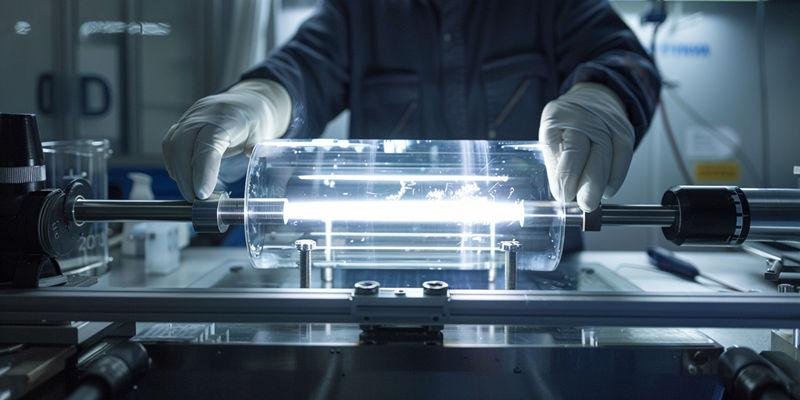Выбор подходящего материала для печных труб имеет решающее значение для инженеров и руководителей технологических процессов, стремящихся обеспечить надежность и эффективность работы в высокотемпературных средах.
Кварцевые и глиноземные печные трубы обладают уникальными преимуществами, но их характеристики при термоциклировании, химическом воздействии и механических нагрузках могут существенно отличаться. Понимание этих различий необходимо для принятия обоснованного и экономически эффективного решения.

Данное руководство содержит структурированное сравнение, информацию по конкретным областям применения и практическую схему принятия решений, которая поможет вам выбрать оптимальную печную трубу для вашего процесса в 2025 году.
Введение в кварцевые и алюминиевые печные трубы: Основы и значение
Кварцевые печные трубы изготавливаются из высокочистого плавленого кварца, известного своей исключительной стойкостью к тепловым ударам и химической инертностью. Глиноземные трубки, состоящие из керамики на основе оксида алюминия, обеспечивают превосходную механическую прочность и стабильность в окислительной атмосфере.
Оба материала широко используются в полупроводниковых, лабораторных и промышленных печах. Их выбор влияет на производительность процесса, частоту технического обслуживания и долгосрочные затраты на оборудование.
Понимание основных свойств и роли каждого типа труб - первый шаг к оптимизации высокотемпературного процесса.
Основные свойства и преимущества кварцевых печных труб по сравнению с алюминиевыми печными трубами
Кварцевые и алюминиевые трубки отличаются по нескольким важнейшим показателям. Кварцевая печная трубаотличается высокой скоростью термоциклирования и химической чистотой, а алюминиевая печная труба - механической прочностью и устойчивостью к некоторым агрессивным средам.
| Недвижимость | Трубка кварцевой печи | Глиноземная печная трубка |
|---|---|---|
| Максимальная температура непрерывной работы (°C) | 1,050-1,200 | 1,600-1,700 |
| Устойчивость к тепловому удару | До 1000°C/мин | До 500°C/мин |
| Химическая чистота (SiO₂/Al₂O₃) | ≥99.995% SiO₂ | ≥99.7% Al₂O₃ |
| Механическая прочность | Умеренный | Высокий |
| УФ/ИК-пропускание | Превосходно | Непрозрачный |
| Типичный режим отказа | Перелом (редко, высокая ΔT) | Трещины (тепловой удар) |
Кварцевые трубки идеально подходят для процессов, требующих частого нагрева и охлаждения, таких как быстрый термический отжиг или CVD1. Алюмооксидные трубки предпочтительны в условиях высоких механических нагрузок или сильного окисления.
Распространенным заблуждением является то, что все печные трубы выдерживают одинаковые тепловые удары. На практике, кварцевые трубки выдерживают изменения температуры до 1000°C/мин, в то время как алюминиевые трубки могут растрескиваться при скоростях свыше 500°C/мин. Для высокочастотного термоциклирования всегда выбирайте кварц и запрашивайте ASTM E2282 данные испытаний на тепловой удар от вашего поставщика.
Производительность в зависимости от области применения: Когда кварц или глинозем превосходят
Выбор между кварцем и глиноземом зависит от конкретных требований вашего технологического процесса.
Кварцевые трубки отлично подходят для отжига полупроводников, быстрой циклической обработки и процессов, чувствительных к загрязнениям. Их низкое тепловое расширение и высокая чистота сводят к минимуму дефекты полупроводниковых пластин и время простоя оборудования.
Алюмооксидные трубки предпочтительны при высокотемпературном окислении, термообработке металлов, а также в условиях абразивной или коррозионной атмосферы. Их механическая прочность и устойчивость к некоторым химическим веществам продлевают срок службы в суровых условиях.
При выборе оптимального материала трубки учитывайте температурный профиль процесса, атмосферу и частоту циклов.
Как выбрать подходящую печную трубу: Система принятия решений
Структурированная система принятия решений помогает инженерам и покупателям оценить все значимые факторы перед выбором печной трубы.
Начните с составления схемы требований к технологическому процессу: максимальная температура, скорость термоциклирования, химическое воздействие и механическая нагрузка. Используйте матрицу сравнения, чтобы оценить кварц и глинозем по этим критериям.
Деревья решений могут еще больше прояснить наилучший выбор. Например, если ваш процесс предполагает быстрые изменения температуры, а чистота имеет решающее значение, то, скорее всего, лучше всего подойдет кварц. Если приоритетом является механическая прочность и экстремальные температуры, предпочтительнее использовать глинозем.
| Фактор выбора | Рекомендации по использованию кварцевой трубки | Рекомендации по использованию алюминиевых трубок |
|---|---|---|
| Быстрое термоциклирование | Да | Нет |
| Высокая механическая нагрузка | Нет | Да |
| Необходима сверхвысокая чистота | Да | Нет |
| Окислительная атмосфера | Нет | Да |
| УФ/ИК-пропускание | Да | Нет |
Практические соображения: Стоимость, закупки и внедрение для обоих материалов
Стоимость, логистика закупок и детали реализации могут повлиять на ваше окончательное решение не меньше, чем технические характеристики.
Кварцевые трубки обычно имеют более высокую начальную стоимость, но могут снизить долгосрочные расходы за счет более низкого уровня технического обслуживания и меньшего количества отказов в условиях термоциклирования. Алюмооксидные трубки могут быть более экономически эффективными для статических высокотемпературных процессов.
При закупках проверяйте сертификаты поставщиков, возможность отслеживания партий и соответствие стандартам ASTM или ISO. Учитывайте сроки изготовления нестандартных размеров или крупных заказов, а также запрашивайте образцы пробирок для пилотных испытаний.
Советы по применению включают в себя правильный монтаж с учетом теплового расширения, регулярный осмотр на предмет микротрещин и соблюдение протоколов очистки для поддержания чистоты и производительности.
Заключение
Выбор между кварцевыми и глиноземными печными трубами требует тщательной оценки технологических потребностей, компромиссов в производительности и общей стоимости владения.
Выбор подходящей печной трубы - это стратегическое инженерное решение. Воспользуйтесь прямыми заводскими поставками TOQUARTZ, инженерной поддержкой и быстрой доставкой, чтобы обеспечить максимальную надежность и эффективность вашего процесса. Свяжитесь с нами для получения консультаций экспертов и индивидуальных решений.
FAQ (часто задаваемые вопросы)
В чем основное преимущество кварцевых печных труб перед глиноземными для быстрого термоциклирования?
Кварцевые трубки обладают превосходной устойчивостью к тепловым ударам, выдерживая до 1000°C/мин, что делает их идеальными для процессов с частыми изменениями температуры.
Как проверить качество печных труб перед покупкой?
Запросите данные испытаний на тепловой удар по стандарту ASTM E228, сертификаты чистоты и соответствие поставщика стандартам ISO или соответствующим отраслевым стандартам.
Какие факторы следует учитывать при заказе печных труб?
Укажите все размеры, чистоту и требования к производительности. Уточните у поставщика целесообразность, время выполнения заказа и документацию.
Как соотносятся кварцевые и алюминиевые трубки по стоимости и обслуживанию?
Кварцевые трубки могут иметь более высокую первоначальную стоимость, но позволяют сократить частоту обслуживания и замены при термоциклировании, в то время как алюминиевые трубки экономически эффективны при статическом и высокотемпературном использовании.
Ссылки:





